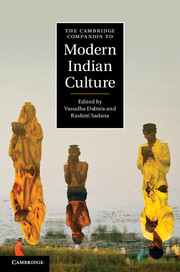Book contents
- Frontmatter
- Introduction
- Part I Cultural contexts
- Part II Cultural forms
- 6 The Bengali novel
- 7 Writing in English
- 8 Dalit life stories
- 9 National tradition and modernist art
- 10 Mass reproduction and the art of the bazaar
- 11 Urban theatre and the turn towards ‘folk’
- 12 Aesthetics and politics in popular cinema
- 13 Musical genres and national identity
- 14 Voyeurism and the family on television
- Further reading
- Index
- Cambridge Companions to Culture
14 - Voyeurism and the family on television
from Part II - Cultural forms
Published online by Cambridge University Press: 28 May 2012
- Frontmatter
- Introduction
- Part I Cultural contexts
- Part II Cultural forms
- 6 The Bengali novel
- 7 Writing in English
- 8 Dalit life stories
- 9 National tradition and modernist art
- 10 Mass reproduction and the art of the bazaar
- 11 Urban theatre and the turn towards ‘folk’
- 12 Aesthetics and politics in popular cinema
- 13 Musical genres and national identity
- 14 Voyeurism and the family on television
- Further reading
- Index
- Cambridge Companions to Culture
Summary
In an interview on a leading Hindi news channel in 2009, Congress Member of Parliament Ambika Soni remarked that she had never watched as much television in her life as she had in the five months since taking office as the Minister of Information and Broadcasting. ‘You never know when an NGO or fellow MP might raise a complaint about a programme being unsuitable for broadcast.’ Her remark referred in part to complaints against specific shows that had been aired on private television channels in 2009; their content had been criticized as being unsuitable for Indian audiences. Soni went on to say that most of the complaints related to the depictions of women or children, and the publicization of issues that Indians consider ‘extremely private’. ‘There are things,’ she said, ‘that Indians are not mentally prepared to publicise in front of everybody … even if we don't do it ourselves, seeing somebody else do it is hurtful.’ The complaints addressed two reality shows that were aired in July and October 2009, both adaptations of foreign reality shows: Sach Ka Samna (‘Facing the Truth’; hereafter SKS) was the Indian version of US television giant Fox's The Moment of Truth and Pati, Patni, aur Woh (Husband, Wife, and the Other; hereafter PPW) was the Indian version of the BBC 3 reality show Baby Borrowers.
- Type
- Chapter
- Information
- The Cambridge Companion to Modern Indian Culture , pp. 264 - 282Publisher: Cambridge University PressPrint publication year: 2012



